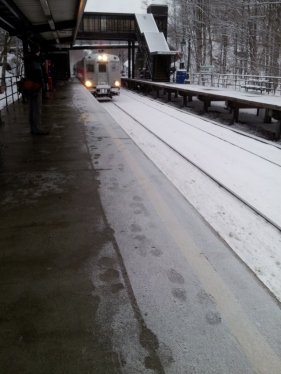 The sound is a simple one; low but powerful. It is a noise that is part of the region’s soundtrack. The deep steady sound of the train’s horn – commuter or freight – lets you know a train is coming.
The sound is a simple one; low but powerful. It is a noise that is part of the region’s soundtrack. The deep steady sound of the train’s horn – commuter or freight – lets you know a train is coming.
And that is its job; to alert people of the massive machine before it reaches platforms, tunnels, or grade crossings. I can imagine it is a sound that many heard seconds before the Harlem Line crash in Valhalla Tuesday night. The sound was quickly replaced by the violence of a crash that killed six people and injured more than a dozen; the noise of an express train hitting a SUV stopped on the tracks, stopped in a spot – by mistake or on purpose – where it should not have been.
While some politicians tactfully began riding in on their white horses just hours after the crash, the number of accidents Metro-North has had at grade crossings is comparably low to other commuter transit agencies. Between, 2012-2014 Metro-North had five accidents at crossings. NJ Transit had 30. Long Island Rail Road had 27. MBTA in Boston had 17. Across all railroads – freight and passenger – deadly accidents at crossings peaked in 1989 with 801. In 2013, that number had fallen to 251. It is true that Metro-North’s safety record has been troubled recently and there should be a thorough investigation into the crash but this one likely wasn’t its fault. The reality is the only way to truly stop accidents at crossings is to not have trains at-grade. Ask Al Smith why there are no grade-level trains in New York City anymore.
There are two crossings like this on the Hudson Line between Cold Spring and Croton-Harmon. One is by the tiny, isolated station at Manitou. The other is north of the Peekskill Station where you can cross for access to a park along the river. This morning, we pushed through these crossings as icy flakes fell from the sky. The train horn sounded, the red lights flashed and the gates went down. A steady tone alerted anyone down the line a train was on its way. Until this week, it was just another noise along the way to Grand Central. But, as the horn sounded this time before we pass through the crossings, it provided me a small but audible connection to this terrible accident. It acted as a personal reminder of the people who died or were injured at a spot very similar. They are people I never met but they were doing the same thing I do every day. Ride the train. Go to work. Head home.
This time, sadly, some of them never made it home.
When you hear a train’s horn – tonight or tomorrow or whenever – think about the people who died or who were injured. Use it as a chance to reflect on how quickly lives can be changed and keep their families in your thoughts.
And, also use that sound – or the flashing red lights or the gates being down – as a reminder of something equally important. There is a train coming.